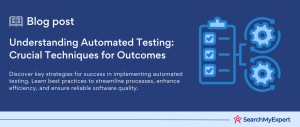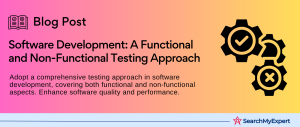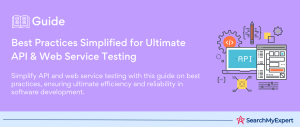Understanding the Need for Cross-Browser Testing
Cross-browser testing is a critical phase in web development that ensures a website or web application functions correctly across different web browsers, devices, and operating systems. This process is essential due to the diverse ways in which browsers interpret and render HTML, CSS, and JavaScript, which are the cornerstone technologies of the web. Here’s a detailed discussion on the impact, potential issues, and the importance of cross-browser testing:
Impact of Different Browsers and Devices on Website Rendering and Functionality
- Rendering Differences:
Each browser has its own rendering engine (e.g., Blink for Chrome, Gecko for Firefox), leading to variations in how websites look and behave. For example, a layout that appears as intended in one browser might break or display incorrectly in another. - JavaScript Engine Variations:
JavaScript execution can significantly differ between browsers, affecting the performance and functionality of web applications. Features implemented using JavaScript or frameworks like React, Angular, or Vue.js may not work uniformly across browsers. - CSS Compatibility: CSS properties and animations might not be supported consistently across browsers, leading to differences in design and user interface. Modern CSS features like flexbox or grid layouts might have limited support in older browsers.
- Device-Specific Issues: The proliferation of devices with varying screen sizes, resolutions, and input methods (touch vs. mouse) complicates web development further. Responsive design techniques are crucial but need thorough testing to ensure they work across all devices.
Potential Usability Issues and Compatibility Problems
- Usability Challenges:
Inconsistencies across browsers can lead to poor user experiences, such as navigation difficulties, inaccessible content, or unresponsive interfaces. This can frustrate users and drive them away from a website. - Compatibility Problems: Newer web standards and features may not be fully supported in older browsers, leading to functionality that’s either broken or unavailable for some users. Ensuring backward compatibility and graceful degradation is important for reaching a wider audience.
- Performance Variability: A site might load quickly and run smoothly in one browser but suffer from slow performance in another due to differences in how browsers handle resources and execute scripts.
Importance of Ensuring a Seamless User Experience Across Various Browsers and Platforms
- Reach and Inclusivity:
Cross-browser testing helps ensure that a website is accessible to the widest possible audience, including users on older browsers and devices. This inclusivity can significantly impact a site’s reach and user engagement. - Brand Consistency and Professionalism:
A website that looks and functions well across all platforms reflects positively on a brand, conveying professionalism and attention to detail. It helps build trust with users, demonstrating that a company values their experience. - Conversion and Retention:
Websites and applications that are accessible, functional, and performant across all browsers and devices are more likely to retain users and convert visits into actions, whether that’s making a purchase, signing up for a newsletter, or another form of engagement.
Exploring Popular Cross-Browser Testing Tools
Cross-browser testing tools are essential for developers and QA teams to ensure their websites and applications work flawlessly across a wide range of browsers and devices. These tools come in various forms, including cloud-based services, local setups, and manual testing frameworks. Here’s an overview of some of the top cross-browser testing tools, their key features, pricing models, and target audiences, followed by a brief look at additional tools for browser compatibility testing.
Top Cross-Browser Testing Tools
BrowserStack
- Key Features:
BrowserStack offers real device testing, a vast selection of browsers and operating systems, and integrations with continuous integration tools. It supports automated and manual testing, including live interactive testing. - Pricing Model:
BrowserStack provides various pricing tiers, including a free trial, individual plans, and enterprise solutions, catering to different user needs and company sizes. - Target Audience:
Developers and QA teams in organizations of all sizes looking for comprehensive testing on real devices.
Sauce Labs
- Key Features:
Sauce Labs specializes in automated testing across browsers and platforms with support for mobile testing. It offers a secure testing environment, access to hundreds of browser/OS combinations, and analytics for test results. - Pricing Model: Pricing ranges from free trials to various paid plans tailored for individuals, small teams, and large enterprises, including custom solutions.
- Target Audience: Businesses and developers requiring a scalable, secure environment for automated web and mobile testing.
Selenium Grid
- Key Features:
Selenium Grid allows for running tests in parallel across different browsers and environments, significantly reducing testing time. It’s part of the Selenium suite, supporting automated tests written in various programming languages. - Pricing Model:
Selenium Grid is open source and free to use, making it accessible for developers and companies of any size. - Target Audience: Developers and QA professionals comfortable with coding their tests and setting up their testing environments.
Browserling
- Key Features:
Browserling offers live interactive cross-browser testing in real browsers. It provides quick access to multiple browser versions without the need for installations or setups. - Pricing Model: It offers both free and paid plans, with the latter providing more features and longer testing sessions.
- Target Audience:
Web developers and small to medium-sized businesses needing quick and easy access to different browser versions for manual testing.
LambdaTest
- Key Features:
LambdaTest supports both automated and manual testing across a wide range of browsers and devices. Features include real-time testing, screenshot testing, and responsive testing, along with integration with various CI/CD tools. - Pricing Model: LambdaTest offers a freemium model with both free and paid plans, making it suitable for freelancers, startups, and large enterprises.
- Target Audience:
Teams and individuals looking for a versatile, cloud-based testing platform that supports both automated and manual testing workflows.
Additional Tools for Browser Compatibility Testing
Browser Developer Tools
- Modern browsers like Chrome, Firefox, and Edge come with built-in developer tools that can simulate various devices, screen sizes, and even network conditions, aiding in preliminary compatibility testing.
Online Testing Platforms
- Platforms such as Can I Use provide up-to-date browser support tables for front-end web technologies, allowing developers to check compatibility issues before starting detailed testing.
Manual Testing Frameworks
- Tools like Ghostlab and Browsersync enable synchronized browser testing, allowing developers to test their websites on multiple devices and browsers simultaneously, reflecting real-time changes across all platforms.
Choosing the Right Tool for Your Needs
Selecting the right cross-browser testing tool for your project is crucial to ensure efficiency, coverage, and the overall quality of the web application or site you’re developing. Here are several key factors to consider, which will help you choose the most suitable tool based on your specific needs:
Budget
- Consideration: The cost of cross-browser testing tools can vary significantly, from free open-source options to premium services. Determine your budget early in the selection process to narrow down your choices.
- Action:
Compare pricing models of different tools, considering not just the upfront costs but also long-term expenses for subscriptions or additional features you might need.
Required Browser and Device Coverage
- Consideration: Your target audience’s preferences and the devices and browsers they use will heavily influence your choice. Some tools offer a wider range of browser and device combinations, including older versions and less common browsers.
- Action:
Identify the browsers and devices most used by your audience and ensure the tool you choose supports them, especially for real device testing.
Automation Needs
- Consideration:
Depending on the size and complexity of your project, you may benefit from automated testing to save time and increase efficiency. Some tools specialize in manual testing, while others offer robust automation capabilities. - Action:
Evaluate your team’s capacity to maintain automated tests and decide if you need a tool that prioritizes automation features, including support for scripting languages and integration with CI/CD pipelines.
Integration with Existing Tools
- Consideration:
Your current development and testing ecosystem, including version control, CI/CD tools, and project management software, should work seamlessly with the cross-browser testing tool. - Action:
Look for tools that offer integrations with your existing setup or have APIs that allow for custom integrations, ensuring a smooth workflow.
Prioritizing Features
After considering the above factors, prioritize features that align with your specific testing requirements:
- Real Browser Testing: Access to real browsers and devices is crucial for accurate testing results, especially for detecting nuanced rendering issues or performance problems.
- Visual Comparison Tools:
For projects where UI and design consistency are critical, visual regression testing features can automatically detect and highlight visual differences across browsers and devices. - Debugging Capabilities:
Advanced debugging tools, including video recordings, screenshots, and console logs, can significantly reduce the time spent identifying and fixing issues.
Making the Decision
- Trial and Evaluation: Many tools offer free trials or limited free plans. Take advantage of these to test out their features, usability, and effectiveness in your testing environment.
- Feedback from Teams: Involve your development and QA teams in the evaluation process. Their insights and preferences can provide valuable feedback on the tool’s fit for your project’s needs.
- Future Scalability: Consider not just your immediate needs but also potential future requirements. A tool that scales easily with your project’s growth can be a more cost-effective choice in the long run.
Implementing Manual & Automated Testing Strategies
Implementing a comprehensive testing strategy that encompasses both manual and automated approaches is essential for ensuring the compatibility and performance of web applications across various browsers and devices. Here’s how to approach both manual and automated testing strategies effectively:
Manual Testing Approaches
Cross-Browser Testing with Different Devices and Browsers Manually
- Process:
Manually testing involves accessing the website or application on various browsers and devices to check for consistency in rendering, functionality, and performance. This includes testing on different operating systems, mobile devices, and browser versions to ensure a wide coverage. - Best Practices:
Keep an updated list of the most popular browsers and devices among your target audience. Use real devices when possible to get the most accurate representation of user experience. Document and track issues meticulously for efficient debugging.
Using Browser Developer Tools for Debugging and Inspecting Rendering Issues
- Process:
Modern browsers come equipped with developer tools that allow for in-depth inspection of HTML, CSS, and JavaScript in real-time. These tools can simulate different screen sizes, test responsive designs, debug JavaScript, and inspect network activity. - Best Practices:
Familiarize yourself with the developer tools in major browsers (Chrome, Firefox, Safari, Edge) to leverage their unique features. Use the device emulation feature to test responsiveness and the console to catch JavaScript errors. Network analysis can help identify performance bottlenecks.
Automated Testing Techniques
Integrating Cross-Browser Testing Tools with Selenium WebDriver or Other Frameworks
- Process:
Automated testing frameworks like Selenium WebDriver can be used to write test scripts that automate the process of testing web applications across multiple browsers. By integrating these scripts with cross-browser testing tools (e.g., BrowserStack, Sauce Labs), you can execute tests on a wide range of browser and device combinations in the cloud. - Best Practices:
Develop a robust test suite that covers critical user paths and edge cases. Use page object models to make your test scripts more maintainable and readable. Integrate your automated tests with CI/CD pipelines to run them as part of your development process.
Developing Cross-Browser Compatible Test Scripts to Cover Various Scenarios
- Process: Writing test scripts that are compatible across different browsers involves understanding the nuances and potential pitfalls of each browser. This includes handling asynchronous operations, compatibility with web standards, and responsive design elements.
- Best Practices: Prioritize test scenarios based on user impact and likelihood of browser-specific issues. Include tests for both functional behavior and visual appearance. Use conditional statements to handle browser-specific functionalities or to skip tests that are irrelevant to certain browsers. Regularly update your test scripts to cover new browser versions and devices.
Combining Manual and Automated Testing
- Balanced Approach:
While automated testing can save time and ensure consistent coverage, manual testing is invaluable for assessing user experience, design, and more subtle interaction issues. A balanced approach leverages the strengths of both methods. - Feedback Loop: Use insights from manual testing to refine and expand automated test suites. Conversely, automated tests can highlight areas that require deeper manual investigation.
Mastering Visual Testing and Cross-Device Compatibility
Visual testing plays a crucial role in ensuring that users experience a consistent and intended user interface (UI) and user experience (UX) across different browsers and devices. This aspect of testing is vital because even minor visual discrepancies can affect the perception of quality and professionalism of a web application or site. Here’s a detailed exploration of visual testing and cross-device compatibility.
Importance of Visual Testing for Consistent UI/UX
- Detects UI Inconsistencies: Visual testing helps identify unintended differences in layout, styling, and responsiveness that might not affect functionality but could negatively impact the user experience.
- Ensures Design Fidelity: It ensures that the final product accurately reflects the intended design, maintaining brand consistency across all platforms.
- Improves User Satisfaction:
By ensuring visual consistency, visual testing enhances the user’s interaction with the website or application, leading to higher satisfaction and engagement. - Facilitates Cross-Device Compatibility:
With the variety of devices and screen sizes available, visual testing ensures that applications are responsive and render appropriately across all target devices.
Tools for Visual Regression Testing and Pixel-Perfect Comparisons
- Selenium WebDriver:
While primarily known for functional testing, Selenium can be extended with tools like Applitools Eyes or Percy for visual regression testing, allowing for automated comparison of screenshots over time. - Applitools Eyes:
Uses AI and machine learning to automate visual testing, offering features for detailed comparisons, including dynamic content handling and root cause analysis. - Percy by BrowserStack: Integrates with your CI/CD pipeline to automatically capture screenshots and highlight visual changes, facilitating review and approval processes.
- Galen Framework:
Offers a specialized language for specifying how the application should look on different devices, enabling pixel-perfect comparisons and layout testing.
These tools automate the comparison of visual elements across different environments, highlighting discrepancies that might be overlooked during manual reviews. They are designed to integrate with existing testing frameworks and CI/CD pipelines, making it easier to incorporate visual testing into the development workflow.
Mobile Responsive Testing Techniques and Emulators
- Responsive Testing: Involves verifying that web applications adjust smoothly to different screen sizes, orientations, and resolutions. This includes testing flexible layouts, images, and CSS media queries to ensure optimal viewing experiences across devices.
- Use of Emulators and Simulators:
Tools like BrowserStack, Sauce Labs, and LambdaTest offer emulators and simulators that mimic various mobile devices and environments. These allow developers to quickly test and identify issues without needing access to physical devices. - Chrome DevTools: Offers a responsive design mode that simulates a wide range of devices, allowing developers to test layouts and functionalities directly within the browser. Similar tools are available in other major browsers, like Firefox Responsive Design Mode.
- Manual Testing on Real Devices: While emulators and simulators provide a good approximation, testing on real devices is crucial for understanding actual user experiences. This approach helps identify issues related to touch interactions, gestures, and device-specific features.
Optimizing Performance and Efficiency
Optimizing test execution speed and resource utilization is crucial in maintaining an efficient development cycle while ensuring the quality of web applications across multiple browsers and devices. Here are strategies to enhance the performance and efficiency of your testing processes:
Parallel Testing on Multiple Browsers and Devices Simultaneously
- Overview:
Parallel testing involves running multiple tests at the same time across different environments, rather than executing them sequentially. This approach significantly reduces the time required for cross-browser and cross-device testing. - Implementation:
Utilize cloud-based testing platforms like BrowserStack, Sauce Labs, or LambdaTest, which offer the infrastructure to easily execute tests in parallel. Ensure your testing framework and setup support parallel execution.
Prioritizing Critical Test Cases
- Critical Path Testing:
Identify and prioritize the test cases that cover the most critical paths of your application. Focusing on these areas ensures that key functionalities are thoroughly tested, optimizing the use of testing resources. - Test Flakiness Detection:
Implement tools and practices to detect and address flaky tests—tests that exhibit inconsistent outcomes without changes to the code. Flaky tests can waste resources and undermine confidence in the testing process.
- Tools:
Use frameworks and services that offer flakiness detection and analytics to identify unreliable tests. - Best Practices:
Regularly review and refactor flaky tests, considering changes in the application and environment that might affect test stability.
Integrating CI/CD Pipelines for Automated Testing
- Continuous Integration/Continuous Delivery:
Integrating automated tests with CI/CD pipelines allows for continuous testing throughout the development lifecycle. This practice ensures that code changes are automatically tested, facilitating early detection of issues. - Benefits:
CI/CD integration enhances the efficiency of the testing process, reduces the manual effort required for test execution, and accelerates the feedback loop to developers. - Implementation: Choose a CI/CD tool that integrates smoothly with your testing tools and framework. Configure the pipeline to trigger automated tests on code commits, pull requests, or scheduled intervals.
Additional Strategies for Optimization
- Test Environment Management: Efficiently manage test environments to ensure they are properly configured and ready for testing. Use infrastructure as code (IaC) tools to automate the provisioning and teardown of environments.
- Smart Test Selection:
Apply techniques like test impact analysis to run only the tests affected by recent code changes, further reducing testing time without compromising coverage. - Resource Allocation: Dynamically allocate resources based on testing needs to optimize utilization. Cloud-based testing platforms often offer scalability options to adjust the testing capacity as needed.
Staying Ahead of the Curve
The landscape of web technologies is in constant flux, with new frameworks, languages, and design paradigms emerging regularly. This evolution drives a parallel shift in testing demands, necessitating that testers and developers stay agile and informed to ensure their applications remain compatible, performant, and secure across all browsers and devices. Here’s how professionals can stay ahead in this ever-changing environment:
Importance of Continuous Learning
- Stay Updated:
With the rapid development of web technologies, what’s cutting-edge today might become obsolete tomorrow. Continuous learning is crucial for understanding the latest trends, tools, and techniques in web development and testing. - Explore New Testing Tools and Techniques:
New tools and methodologies are regularly introduced to address the complexities of modern web applications. Experimenting with these can uncover more efficient ways to tackle testing challenges, especially those related to cross-browser compatibility and performance.
Engaging with the Testing Community
- Participate in Forums and Groups:
Platforms like Stack Overflow, Reddit, and LinkedIn host vibrant communities of web developers and testers. These forums are invaluable for seeking advice, sharing knowledge, and staying abreast of industry trends. - Attend Conferences and Workshops:
Conferences, webinars, and workshops are excellent opportunities to learn from thought leaders and innovators in the field. They provide insights into future trends and offer networking opportunities with peers. - Contribute to Open Source Projects: Engaging with open-source projects can offer practical experience with the latest web technologies and testing practices. It’s also a way to contribute to the community and learn from the collective knowledge of developers worldwide.
Sharing Best Practices
- Document and Share Learnings:
Whether through blog posts, tutorials, or talks, sharing your experiences and insights can help others navigate similar challenges. It also positions you as a thought leader in the testing community. - Implement Best Practices in Your Team:
Foster a culture of knowledge sharing within your organization. Regularly review and update your testing strategies to incorporate the latest best practices and tools. Encourage team members to share their findings and learnings from individual explorations or external engagements.
Continuous Improvement and Innovation
- Experimentation: Don’t shy away from experimenting with new technologies and testing approaches. Innovation often comes from pushing boundaries and trying out new ideas.
- Feedback Loops: Implement efficient feedback mechanisms to learn from testing outcomes. Continuous integration and delivery (CI/CD) pipelines, along with automated testing, can provide rapid insights into the impact of changes.
Conclusion
As the digital landscape continues to evolve at a breakneck pace, mastering the art of web development testing has never been more critical. The key to success lies in a proactive approach to learning, an openness to innovation, and a commitment to sharing knowledge within the community. By staying informed about the latest technologies, testing tools, and methodologies, and by actively participating in the broader testing community, professionals can not only navigate the complexities of today’s web environment but also shape its future.
Revolutionize your QA process with our Software Testing Service.
Table of Contents
Toggle






